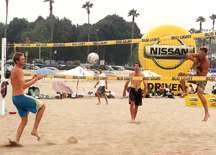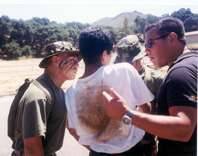Cars filter down a bucolic, dirt road to the Diamond X Ranch near Malibu amid a buzz of katydids and spacious horse pastures. With children in tow, parents’ beam out windows, perhaps to get a hint of the road ahead. For some teens, it’s a much needed break, for others, it’s a traumatic payday for deeds that began as their excellent adventure.
“Get out of the car!” shouts a Marine. “Get out of the car!” spits another. “Now get over there!” All but yanked from their vehicles, teens are forced to lie facedown while shaken for weapons.
“Now you better get used to this position” advises one Marine. “Continue in your lifestyle and this is the position you’ll be in for a very long time.”
This scene is described by a key “camp” official who called the first day’s initiation “tough,” but added, “Parents were doing high-fives.”
No, it’s not a campaign to join the Marines nor a sequel to “Full Metal Jacket,” but a sobering dose of reality: A “boot camp” for “at risk” youth–a second chance for many who might otherwise be serving time in Juvenile Hall or a detention facility for minors.
The pioneering program known as VIDA (Vital Intervention Directional Alternatives), meaning “life” in Spanish, was created and launched by the Los Angeles Sheriff’s Dept. in East Los Angeles in 1997 to “increase self-esteem” and “redirect” troubled youth, whose offenses run the gamut from petty theft to felonies, now in operation in 14 locations.
Deputy Thomas Spiegle of the Lost Hills/Malibu Sheriff’s Station, credited with spearheading the VIDA program at his station, works jointly with other deputies, Marines and park officials in running the 16-week program at the Diamond X Ranch each Saturday from 7:45 a.m. to 5 p.m.
The weekly regimen begins with approximately four hours of challenging, often grueling exercises including jogging, push-ups and sit-ups meant to build confidence and “team cooperation.”
After a bag lunch, afternoons revolve around educational tutoring where VIDA children receive support with their school work followed by community-service activities, some led by parks personnel from the Santa Monica Mountains National Recreation Area, in resource protection, property revitalization and construction projects.
Malibu parent, Katie Jones (not her real name) spoke of the keen influence peer-pressure may have played in what she called her son’s “inexplicable” turn and subsequent involvement with “the wrong kids,” which brought her son to VIDA.
After moving to a new neighborhood, Jones said her son, then 17, burglarized three homes with another boy when “there was plenty of supervision at home,” a point she appears perplexed over. “The Sheriff’s Department found out four or five months later,” said Jones. “[My son] was arrested and had to go to Juvenile Hall for two weeks. We paid restitution, one of the neighbors sued–that was a huge amount of money to pay off.”
Many who find themselves in VIDA have been court-ordered to participate as part of their probation, or sent to the program in lieu of Juvenile Hall. Others are voluntarily placed in the program by “desperate parents” who lament they “have lost control” of their sons.
Designed to shock participants’ conscience and awaken them to the realities of prison life, the program is seen by some parents as an extreme, yet critical measure to deter their children from a life of ill consequences, likely incarceration and premature death.
Drug and alcohol dependency problems can and do instigate crimes for many children, according to VIDA sources, while it is not unusual for those described as having “rage or anger management problems” to propel a common situation to spin out of control.
Robert Lopez (not his real name), 16, reports the numerous times he has been arrested since the age of 12 and is a court-ordered VIDA participant. While “high on crystal-meth,” Lopez found he was “always angry,” which led to an incident that brought him to VIDA. Lopez says a motorist shouted for him to “hurry up and cross the street” while on his bike one day.
“I took out a switchblade and started swinging toward him,” recalled Lopez. “There was a cop-car right behind me, I got arrested right away.”
Initially hoping that “Saturday wouldn’t come,” Lopez says he now “enjoys the exercise” and looks forward to the weekend. “Before I was working hard to get into a gang, now I really don’t want to.”
As to the verbal “attitude correction” they receive, Lopez said, “They’re doing a job–but they do care about us–you could tell.”
While the VIDA “boot camp” is said to have a failure rate of two-thirds of all those who participate, according to Spiegle, there is an approximate 98 percent success rate among those who complete the program.
Cameron David (not his real name), 16, also a court-ordered participant, sees the program as a viable alternative to jail.
“I am glad I came to this program as a second chance. It’s a lot better than Juvenile Hall,” said David. “I’ve never been screamed at like that [at VIDA]. You can’t win–there’s nothing you can do in return–you might as well go with it, you know?”
David said he was placed in VIDA after a hit and run (no one was killed) and driving without a license. Acknowledging a drug problem, he offered, “I’ve been clean for 152 days” and appeared to take pride when stating, “I’m a published poet.”
His parents later confided that David was also responsible for a “hate crime,” an incident wherein he left a lewd note on someone’s car. His mother painfully revealed that their son had taken to “drawing swastikas,” and allegedly pinned a note on a friend signed “Hitler,” to which his father poignantly responded, “And I am Jewish.”
“When dealing with youth, you can still catch them at a point where their minds are still open and still have some kind of impact,” said Spiegle. “This program emphasizes choices and consequences.”
According to program participants as well as volunteers, VIDA is far more than interminable push-ups and deafening Marines. Spiegle and others highlight the weekly counseling sessions for parents and children conducted by ACTION, a nationally recognized teen/parent support program focused largely on drug and alcohol abuse intervention, in addition to home and school visits by deputies who appear without warning to monitor children and teens in the program.
Marine Sgt. Charles Spence, 34, a VIDA volunteer who makes the trek from Costa Mesa each Saturday, offered insight into the mindset of some. According to Spence, he was once at risk himself.
“I had a three-foot green Mohawk and [thought] I was one slick character. I tell the kids this is not a cake-walk–we are going to be firm but fair.”
“Given the environment that a lot of these kids are coming from, it’s easier to blame someone else or join a gang,” said Spence. “They’ve lost all respect for themselves. That saddens me. People try to let the village raise a child and it just doesn’t work.”
Several sources underscored that those who fail VIDA and were court-ordered to attend will return to Juvenile Hall or repeat the program, while others who commit crimes during the 16 weeks will be re-arrested.
As Lt. Ken Fowler, Detective Bureau commander at Lost Hills, pointed out, “We do urine tests twice during the program and we’ll screen for any number of illegal substances, ,including alcohol. If a kid has one dirty test, he fails the program and has to repeat it.”
“When we tour the state prison and [VIDA kids] speak to ‘life-ers,’ that’s a harsh reality,” said Robert DeSantis, a tough-talking, but big-hearted deputy who hails from Brooklyn. “If they don’t straighten out, they will go to jail. Jail is almost worse than prison, there is no segregation according to law. And they’re mixed in with gang-bangers.”
In what some might call a “scared straight” tactic, it is reportedly an effective one, as Spiegle describes a VIDA “field trip” to the county morgue where VIDA participants view corpses of those close to their age, some who were gang-bangers “who didn’t plan on dying, but who made high-risk choices and died as result.”
While the program is no magic pill, perhaps Spence summarized VIDA’s promise best when saying, “This is only the second drill, but by the 16th drill, I’ll be shaking hands with a lot of fine young men who now know they have choices.”





